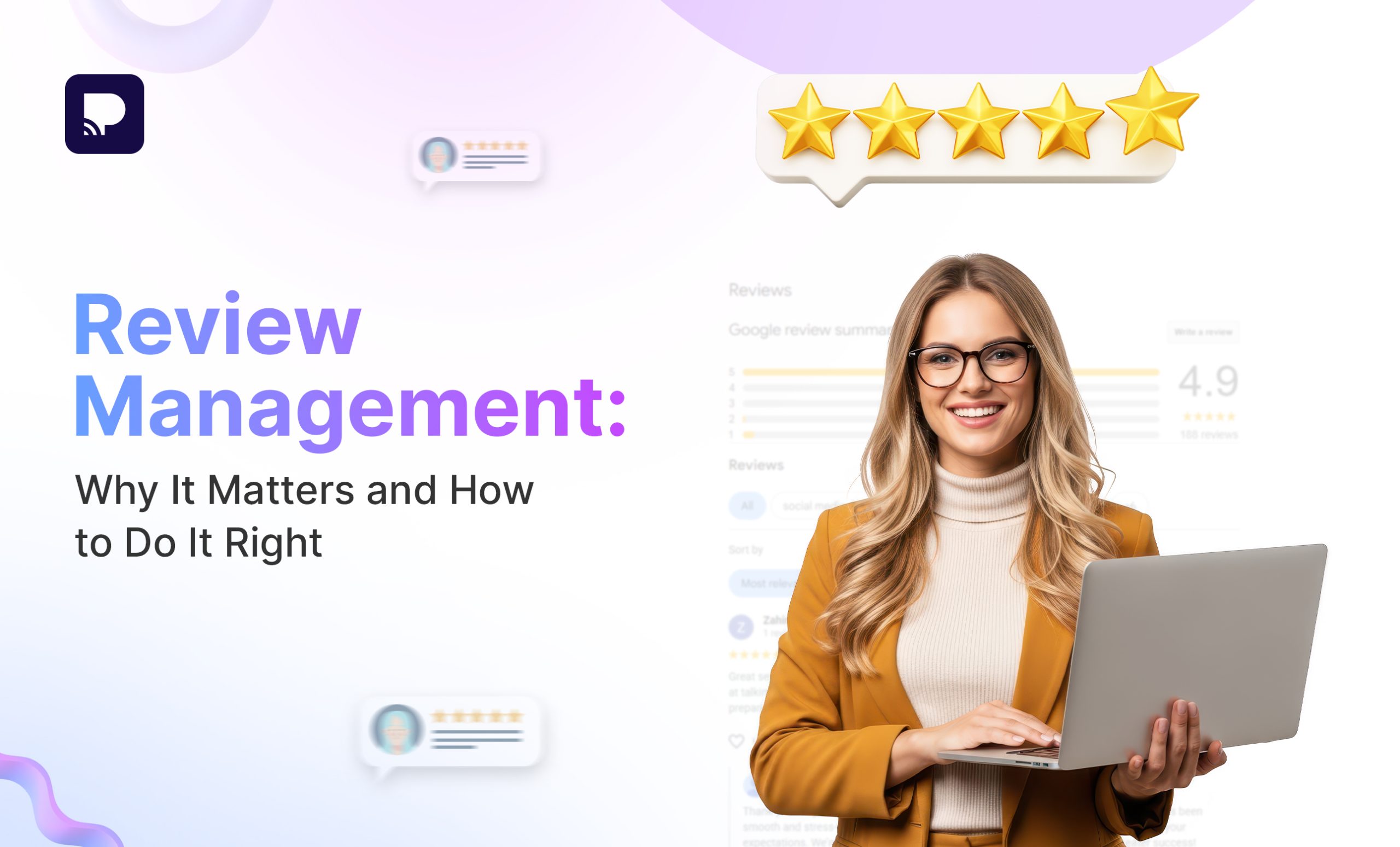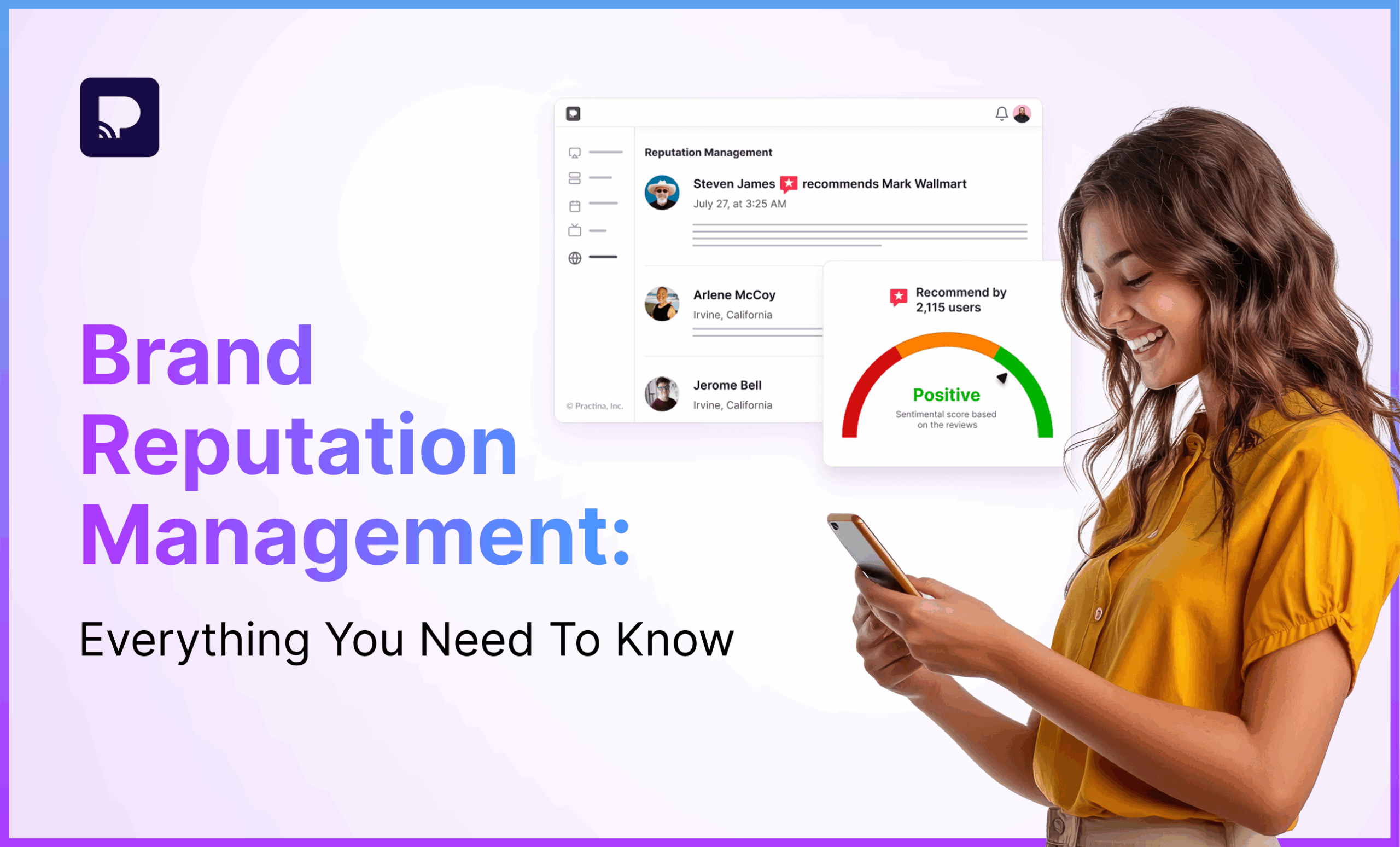Digital footprint matters. And for business owners, even more so. Here’s the thing: what your brand publishes is important, but what customers publish about your brand is often far more influential. Your reviews shape discovery, trust, conversion, hiring, partnerships, and even product decisions. And how those reviews are managed determines whether they become growth fuel or a slow leak in your brand reputation.
This blog explains what review management is, why you need to monitor online reviews, five concrete reasons it matters, and a step by step strategy you can execute. The guide ends with a short overview of how Practina helps make review responses stress free and a practical walkthrough of Reputation AI.
What is Review Management?
Review management is the continuous process of collecting, monitoring, analyzing, responding to, and leveraging customer reviews across every online channel where customers talk about your brand. It covers public review sites like Google Business Profile, Facebook, Yelp, Apple Maps, industry specific directories, marketplaces like Amazon, in app reviews, and social media mentions that function like reviews.
A robust review management practice has three active functions:
- Capture. Make it simple for customers to leave reviews across channels. This includes follow up emails, QR codes in store, post purchase prompts, and review widgets on your site.
- Monitor. Track reviews in a central place so nothing is missed. Monitoring goes beyond reading new five star posts. It includes tracking sentiment trends, common complaints, recurring praise, and changes over time.
- Act. Respond publicly and privately. Fix legitimate issues. Thank positive reviewers. Turn top reviews into marketing assets. Feed insights back to product, operations, and customer service.
Example:
Imagine a local cafe with three recurring review signals:
• Multiple customers mention slow counter service at the lunch hour.
• Several reviewers praise a new pastry called the saffron croissant.
• One guest posts a detailed complaint about a rude cashier and posts photos.
Review management for this cafe would look like this:
- Capture: After a purchase the cafe sends a simple SMS asking for feedback with a direct link to Google reviews.
- Monitor: All incoming reviews from Google, Facebook, and the cafe website are consolidated into a dashboard. The operator notices lunchtime slow service is trending up.
- Act: The cafe replies publicly to the rude cashier post with empathy, offers a private channel to resolve, and documents the incident for HR. For the lunch rush issue the cafe adjusts staffing and speeds up the point of sale. For the saffron croissant the cafe creates a social post and features it on the menu because that praise is a differentiator.
This is review management in practice: capture the signal, make sense of it, and convert the signal into action that improves experience and growth.
Why You Need to Monitor Online Reviews
Reviews reveal more than whether customers like your product. They reveal operational gaps, product strengths, content opportunities, and competitor position. A single recurring complaint can highlight a process failure. A cluster of praise can become a core marketing message. Monitoring reviews across every online platform is essential because the conversation is dispersed and decisions are made quickly by prospective customers.
When a customer writes about slow service, shipping damage, exceptional product quality, or a helpful employee they are giving you raw data. That data is actionable. Use it to fix problems fast, to double down on what people love, and to tighten your positioning.
Additional value to monitoring reviews
• Product road map input. Reviews help prioritize fixes and features customers actually demand.
• Reduced churn. Fast, empathetic responses can turn unhappy customers into loyal ones.
• Marketing fuel. Authentic review excerpts convert better than generic ad copy.
• Competitive insight. Reviews often compare your business to competitors. Learn where you win.
• Legal and compliance signals. Reviews can surface regulatory or safety issues before they escalate.
Monitor online reviews not because it is trendy but because it closes the loop between real customer experience and business outcomes.
Why Business Review Management Online Is Important
We already covered why monitoring reviews is necessary. That alone suggests review management is crucial. Customer review management is not just damage control. It is a strategic capability that strengthens brand reputation, improves conversions, and feeds continuous improvement.
Here are five concrete reasons to invest in business review management online, with scenarios and examples.
1. Reviews affect conversion and search visibility
Evidence from multiple studies shows that higher review volume and better average ratings increase conversion and local search ranking. Scenario: two similar clinics appear in local search results. Clinic A has 150 reviews averaging 4.7. Clinic B has 12 reviews averaging 3.9. Most people choose Clinic A because reviews signal trust and legitimacy. Action: actively solicit reviews from satisfied customers, manage average rating by resolving legitimate complaints, and respond to reviews to increase reviewer trust and click through rate.
2. Reviews are real time product and service feedback
Scenario: an e commerce brand sees recurring comments about ripped packaging on arrival. The brand investigates and discovers a supplier packing issue. Fix: change packaging or supplier, update quality control, and reply to reviewers explaining the corrective steps. Result: fewer negative reviews and lower return rates.
3. Public responses shape public perception
How a business replies to praise or complaints signals values and competence. Scenario: a hotel responds to a negative review with a defensive reply. That reply becomes as visible as the original complaint and drives additional negative sentiment. Alternative: reply with empathy, acknowledge the issue, propose a resolution, and invite private conversation. That response demonstrates care, reduces escalation, and often converts an unhappy reviewer into a repeat customer.
4. Reviews amplify social proof and drive organic marketing
A five star review is a short authentic endorsement. Scenario: a salon turns a detailed five star review into a short testimonial post, runs it in an email, and adds the excerpt to a service page. The testimonial outperforms a typical promotional post because it is authentic. Action: select high signal reviews, get permission if necessary, and amplify as social posts, ads, or landing page copy.
5. Reviews help you stay competitive and proactive
Reviews often call out ways competitors are better or worse. Scenario: customers praise a competitor for free pickup. Your monitoring reveals this trend and you launch a pickup program to neutralize the competitor advantage. Action: use reviews as competitive intelligence and respond strategically.
Building a Strategy to Manage Online Reviews
Executing an online review management plan is as complex as it is important. There are practical ways to streamline the process so it scales with your business.
Follow this step by step strategy to establish effective online reputation management.
1. Monitor your reviews across the web
Why: Customer feedback appears on many platforms. Missing reviews risks unanswered complaints and lost opportunities.
Challenges: Reviews are scattered across Google, Facebook, Yelp, marketplace pages, app stores, and industry sites. Tracking them manually requires multiple logins and constant checking.
Solution: Consolidate reviews in a single dashboard. Use a platform that pulls reviews from all sources so you can prioritize and act from one place. This reduces missed reviews, speeds up response times, and centralizes metrics for teams.
Practical tip: Set up filters by rating, sentiment, and urgency so your team sees the highest impact items first.
2. Reply to positive reviews
Why: Positive reviews are relationship fuel. Acknowledging praise reinforces loyalty and increases the likelihood of referrals.
Challenges: Generic replies feel robotic and wasteful. Personal replies take time. High volume of positive reviews can overwhelm teams.
Solution: Use templated yet personalized responses or AI generated drafts that match your brand voice. Example response for a coffee shop: “Thanks for the kind words, Arjun. Happy you loved the saffron croissant. Next time tell us and we will add a free espresso shot.” This feels human and drives repeat visits.
Practical tip: Add a small call to action in select positive replies. Offer a discount for referrals, invite photo tags, or encourage signing up for a loyalty program.
3. Resolve negatives with empathy and speed
Why: Negative reviews can damage conversion if left unaddressed. A well handled negative review can produce more loyalty than an ignored positive review.
Challenges: Responding well requires tone, facts, and a remediation plan. Untrained staff may respond defensively or miss the root cause.
Solution: Train staff on an empathy first template: acknowledge, apologize without admitting unnecessary liability, propose a specific fix, and provide a private channel for resolution. When volume is high, use AI assisted response suggestions that are aligned with your brand tone. These can propose the right words and next steps based on the content of the complaint.
Example: For complaints about billing errors use a response like: “We are sorry this happened. We will review your bill and refund any overcharge within 72 hours. Please message us at care@brand.com with your order number.” That statement is specific and actionable.
4. Turn positives into marketing material
Why: Authentic reviews are high converting. They are social proof you already own.
Challenges: Manual creation of graphics and copy from reviews is time consuming. Permissions and formatting issues add friction.
Solution: Automate creative templates that pull review text, reviewer name, rating, and product photos into ready to post assets. Use a central queue to approve and schedule these posts so marketing and legal can sign off quickly.
Example: An ecommerce store automatically converts top reviews into carousel posts and includes a direct product link. The posts drive better click through rates than standard product images.
5. Measure, learn, and iterate
Why: You must know whether your review management moves the needle.
Challenges: Raw numbers without context can mislead. A spike in negative reviews could reflect an honest backlog or a single bad actor.
Solution: Track trends not just counts. Monitor average rating by location, recurring complaint categories, response time, and conversion on pages that display reviews. Use these metrics to prioritize operational changes and marketing plays.
Practina: Making Review Responses Stress Free For You
With Practina in charge, responding to reviews becomes easier, faster, and hassle free. Practina’s Reputation AI consolidates reviews from multiple sources into a single dashboard so there is no more switching between platforms. The platform analyzes sentiment, suggests several on brand response variations, and allows regeneration until the response is the right fit.
Practina also automates the repurposing of positive reviews into ready to post social content and supports multilingual responses so you can reply in the reviewer’s language. The result is faster resolution, higher engagement, and more marketing fuel from genuine customer voices. Try it now.
Guide to Using Practina Reputation AI
Follow this pragmatic walkthrough to get Reputation AI working for your brand.
- Log in to your Practina account
Sign up for a new account or sign into an existing one. - Activate Reputation AI and connect review platforms
Connect Google Business Profile, Facebook, Yelp, marketplace profiles, app stores, and any industry directories you use. Reputation AI will fetch historical and new reviews into one view. - AI generate responses for reviews
For each review, Reputation AI suggests multiple on brand replies. Review the suggestions, customize if needed, and regenerate variations until the tone and content are correct. - Ready to post review templates
Select top reviews and convert them into social posts or website testimonial cards using Practina’s templates. Approve and schedule directly from the platform. - Bonus: Multilingual support
Respond in the reviewer’s language. Reputation AI supports multilingual reply generation so the reply feels native and respectful. - Turn on notifications to stay in the know
Enable alerts for new reviews, negative sentiment spikes, and high priority items so your team responds fast. - Automate and streamline
Set auto replies for low risk cases, assign tickets to the right team members, and set SLA triggers so no review sits unanswered. - Display best reviews on your website with the review widget
Integrate the Practina review widget to showcase top reviews on your site. It is easy to embed and updates automatically with new positive feedback.
Conclusion
Review management is not a marketing extra. It is a core capability that closes the gap between real customer experience and measurable business outcomes. Monitor every review, respond with empathy and precision, turn praise into proof, and feed insights back to operations. Do not treat reviews as noise. Treat them as a continuous signal system that identifies risk and opportunity.
Invest in a reproducible process and the right tools so responses are timely, consistent, and aligned with your brand. The payoff is clear: higher trust, improved conversion, fewer repeat issues, and better product market fit.
If your priority is Review Management, Practina’s Reputation AI gives you a single control center to manage online reviews, generate on brand responses, publish social proof, and extract insights. Manage online reviews with purpose and the outcomes will follow.







